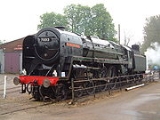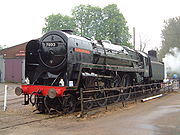
Bressingham Steam & Gardens
Encyclopedia


Museum
A museum is an institution that cares for a collection of artifacts and other objects of scientific, artistic, cultural, or historical importance and makes them available for public viewing through exhibits that may be permanent or temporary. Most large museums are located in major cities...
, gardens and garden centre located at Bressingham, west of Diss
Diss
Diss is a town in Norfolk, England close to the border with the neighbouring East Anglian county of Suffolk.The town lies in the valley of the River Waveney, around a mere that covers . The mere is up to deep, although there is another of mud, making it one of the deepest natural inland lakes...
in Norfolk
Norfolk
Norfolk is a low-lying county in the East of England. It has borders with Lincolnshire to the west, Cambridgeshire to the west and southwest and Suffolk to the south. Its northern and eastern boundaries are the North Sea coast and to the north-west the county is bordered by The Wash. The county...
, England
England
England is a country that is part of the United Kingdom. It shares land borders with Scotland to the north and Wales to the west; the Irish Sea is to the north west, the Celtic Sea to the south west, with the North Sea to the east and the English Channel to the south separating it from continental...
. The site has several narrow gauge rail lines and a number of types of steam engines and vehicles in its collection and is also the home of the national Dad's Army
Dad's Army
Dad's Army is a British sitcom about the Home Guard during the Second World War. It was written by Jimmy Perry and David Croft and broadcast on BBC television between 1968 and 1977. The series ran for 9 series and 80 episodes in total, plus a radio series, a feature film and a stage show...
exhibition.
The Gardens
The gardens were established by Alan BloomAlan Bloom (plantsman)
Alan Herbert Vauser Bloom was a British Horticulturist and steam engine enthusiast. During his life he created over 170 new varieties of hardy perennial plants. These and Alpine plants were his specialities. He wrote some 30 books and appeared on radio and television...
MBE
Order of the British Empire
The Most Excellent Order of the British Empire is an order of chivalry established on 4 June 1917 by George V of the United Kingdom. The Order comprises five classes in civil and military divisions...
at Bressingham Hall. He moved to Bressingham in 1946, after selling his previous 36 acres (14.6 ha) site at Oakington
Oakington
Oakington is a small village 4 miles north-west of Cambridge in Cambridgeshire in England, and belongs to the administrative district of South Cambridgeshire. The village falls into the parish of Oakington and Westwick.-History:...
in Cambridgeshire
Cambridgeshire
Cambridgeshire is a county in England, bordering Lincolnshire to the north, Norfolk to the northeast, Suffolk to the east, Essex and Hertfordshire to the south, and Bedfordshire and Northamptonshire to the west...
to raise the capital for the 220 acres (89 ha) in Norfolk
Norfolk
Norfolk is a low-lying county in the East of England. It has borders with Lincolnshire to the west, Cambridgeshire to the west and southwest and Suffolk to the south. Its northern and eastern boundaries are the North Sea coast and to the north-west the county is bordered by The Wash. The county...
, where he hoped to be both a farmer and a nurseryman. He was a plant expert of international renown, particularly in the field of hardy
Hardiness (plants)
Hardiness of plants describe their ability to survive adverse growing conditions. It is usually limited to discussions of climatic adversity. Thus a plant's ability to tolerate cold, heat, drought, flooding, or wind are typically considered measurements of hardiness. Hardiness of plants is defined...
perennial
Perennial plant
A perennial plant or simply perennial is a plant that lives for more than two years. The term is often used to differentiate a plant from shorter lived annuals and biennials. The term is sometimes misused by commercial gardeners or horticulturalists to describe only herbaceous perennials...
s. He laid out the Dell garden with its well-known island beds. His son, Adrian Bloom, laid out the Foggy Bottom garden.
Much of the site is given over to commercial horticulture. There is a garden centre on the site, trading as Blooms of Bressingham, although the nurseries themselves are not open to the public. Bressingham Gardens and Steam Museum is an independent charitable trust
Charitable trust
A charitable trust is an irrevocable trust established for charitable purposes, and is a more specific term than "charitable organization".-United States:...
. Alan Bloom had wanted to create his own trust in 1967, to ensure that the collection would not be dispersed to pay for death duties, but the laws of the time made this difficult, and after five years of negotiation, the museum was nearly handed over to the Transport Trust. However, the legislation governing private museums was relaxed just before the handover in 1971, and Bloom was able to create his own Trust and thus retain control of it because the collection was of historical and educational importance.
The Narrow Gauge Lines
There are three railway lines which take visitors around the gardens:- The Garden Railway - gauge miniature railwayRidable miniature railwayA ridable miniature railway is a ground-level, large scale model railway that hauls passengers using locomotives that are models of full-sized railway locomotives .-Overview:Typically they have a rail track gauge between and , though both larger and...
- The Nursery Railway - gauge narrow gauge railway
- The Waveney Valley Railway - gauge miniature railwayRidable miniature railwayA ridable miniature railway is a ground-level, large scale model railway that hauls passengers using locomotives that are models of full-sized railway locomotives .-Overview:Typically they have a rail track gauge between and , though both larger and...
The site also contains a short standard gauge
Standard gauge
The standard gauge is a widely-used track gauge . Approximately 60% of the world's existing railway lines are built to this gauge...
section of track and standard gauge footplate rides are sometimes available to visitors.
Standard gauge steam locomotives
- GNR Class C2 4-4-2 No. 990 Henry Oakley. On static display, on loan from the National Railway MuseumNational Railway MuseumThe National Railway Museum is a museum in York forming part of the British National Museum of Science and Industry and telling the story of rail transport in Britain and its impact on society. It has won many awards, including the European Museum of the Year Award in 2001...
. - GNR Large boiler Class C1 4-4-2 No. 251. On static display, on loan from the National Railway Museum.
- GER Class T26GER Class T26The GER Class T26 was a class of 2-4-0 steam tender locomotives designed by James Holden for the Great Eastern Railway. At the 1923 grouping they passed to the London and North Eastern Railway, who classified them E4. Eighteen survived into British Railways ownership in 1948, and the last was...
2-4-0 No. 490. On static display, on loan from the National Railway Museum. - LT&SR 79 ClassLT&SR 79 ClassThe London, Tilbury and Southend Railway 79 Class is a class of 4-4-2T suburban tank engines. They were designed by Thomas Whitelegg, as a development of the earlier 37 Class....
4-4-2T No. 80 Thundersley. On static display, on loan from the National Railway Museum. - NSBNorwegian State Railways (1883–1996)The Norwegian State Railways was a state-owned railway company that operated most of the railway network in Norway. The government agency was created in 1883 to oversee the construction and operation of all state-owned railways in Norway...
2-6-0 No 377 King Haakon VII. In working order, restored in 2006. - LSWR B4 classLSWR B4 ClassThe London and South Western Railway B4 class is a class of 0-4-0T dock tank.The London and South Western Railway's built twenty to a design by their Locomotive Superintendent William Adams at its Nine Elms Works during the 1891–1893 period...
No 102 Granville 0-4-0T. On static display. - LB&SCR A1 classLB&SCR A1 ClassThe London, Brighton and South Coast Railway A1 Class is an English class of 0-6-0T steam locomotive. Designed by William Stroudley, 50 members of the class were built in 1872 and between 1874 and 1880, all at Brighton Works. The class have received several nicknames, initially being known as...
0-6-0T No 662 Martello. Operational, usually on loan to other railways. - "Peer Gynt". German-built Norwegian Army train used in the early 1950s. Found in a caved-in tunnel and restored, now on static display. Cannot be fully repaired due to the boiler being filled with asbestosAsbestosAsbestos is a set of six naturally occurring silicate minerals used commercially for their desirable physical properties. They all have in common their eponymous, asbestiform habit: long, thin fibrous crystals...
.
Showman's Engines and Road Locomotives
- BurrellCharles Burrell & SonsCharles Burrell & Sons were builders of steam traction engines, agricultural machinery, steam trucks and steam tram engines. The company were based in Thetford, Norfolk and operated from the St Nicholas works on Minstergate and St Nicholas Street some of which survives today.At their height they...
Showman's engine Black Prince, built in 1935. - Road locomotive President.
Steam Engines Portable and others
- Burrell No. 2363 of 1901 Portable.
- E. Youngs Portable of 1910
- Tidman Centre Engine (fairground) No. 1891
- Merryweather Fire engine no. 3702
- Merryweather Fire pump of 1914
Steam Rollers
- Burrell No. 3962 Boxer of 1923 reg no. PW 1714
- Burrell No. 3993 Buster of 1924 reg no. CF 5646
- Robey (company) 4 ton Tandem Steam Roller No. 42520 Barkis built in 1925 reg No. FE 7632.
Steam Tractors / Traction
- GarrettRichard Garrett & SonsRichard Garrett & Sons was a manufacturer of agricultural machinery, steam engines and trolleybuses. Their factory was Leiston Works, in Leiston, Suffolk, United Kingdom.The company was active under its original ownership between 1778 and 1932....
5 ton Steam Tractor No. 34641 Bunty, built in 1924 reg no. CF 5913. - SentinelSentinel Waggon WorksSentinel Waggon Works Ltd was a British company based in Shrewsbury, Shropshire that made steam-powered lorries, railway locomotives, and later, diesel engined lorries and locomotives.-Alley & MacLellan, Sentinel Works, Jessie Street Glasgow:...
11 ton Timber Tractor No. 8756 Brutus, built in 1933 reg no. VN 4294. - Burrell Traction engine No. 3112 Bertha of 1909 reg no. CF 3440
- FosterWilliam Foster & Co.William Foster & Co Ltd was an agricultural machinery company based in Lincoln, Lincolnshire, England and usually just called "Fosters of Lincoln." The company can be traced back to 1846, when William Foster purchased a flour mill in Lincoln. William Foster then proceeded to start small scale...
Traction engine No. 2821 Beryl of 1903 reg. no. BE 7448 - FowlerJohn Fowler & Co.thumb|right|John Fowler & Co. [[steam roller]] of 1923John Fowler & Co Engineers of Leathley Road, Hunslet, Leeds, West Yorkshire, England produced traction engines and ploughing implements and equipment, as well as railway equipment. Fowler also produced the Track Marshall tractor which was a...
Traction engine No. 6188 Beulah of 1890 reg no. MA 8528
Steam Wagons
- Foden Steam Wagon No. 13708 of 1930 Boadicea reg no. VF 8862.

